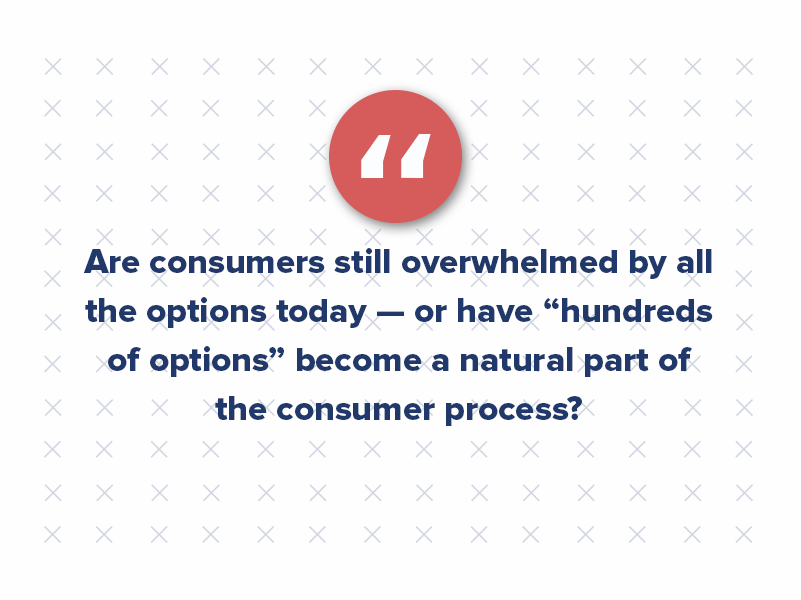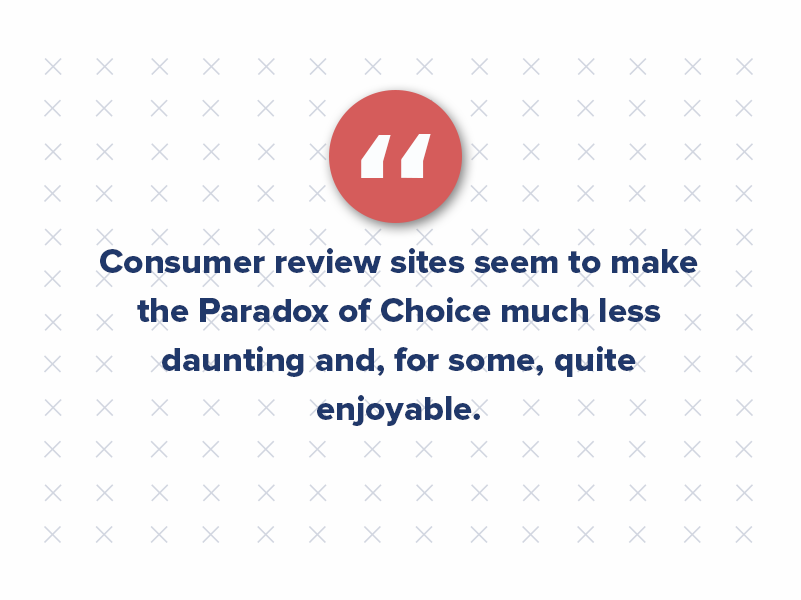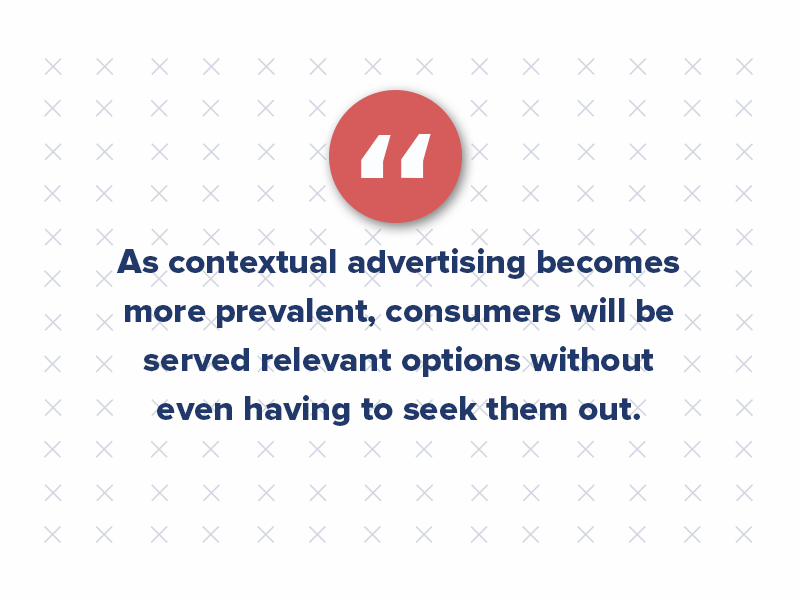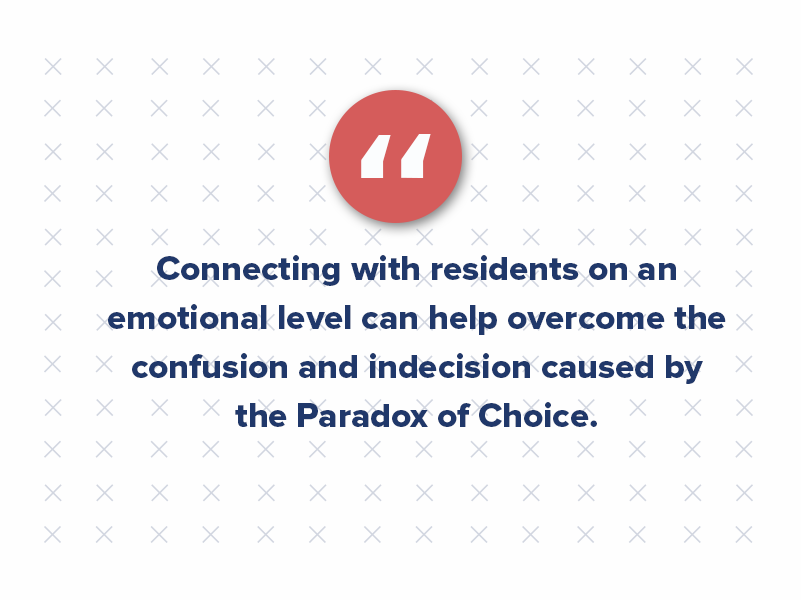Is the Paradox of Consumer Choice Still Valid?
Do you ever feel overwhelmed by the number of product choices available today? Whether it’s cars or toothpaste, consumers have more choices than ever. Sometimes, all these choices can leave you feeling confused or even regretful when you finally make a buying decision. This idea has been called the “Paradox of Choice,” and it impacts apartment marketing more than you think.

The Paradox of Choice
More than a decade ago, the Paradox of Choice was a popular consumer behavior theory, debunking the old idea that more is better. Instead, more choices — too many, in fact — overwhelm shoppers and create anxiety. Ultimately, these shoppers walk away without a purchase because they could not decide or they feel deep buyer’s remorse: “Ugh, I could have picked something better!”
Consequently, some companies simplify product choices to avoid this conundrum. Think of Apple’s product branding and packaging motif: clean, simple, and minimalistic. The company uses only a limited spectrum of bright colors, and the latest and greatest Apple products and iPhones typically come in up to four quintessential colors, not ten.
Regarding logistics, McDonald’s and several other fast food chains have cut several items from their menus. According to McDonald’s, people take longer to order when an extensive menu holds up lines.
The Internet: More Choices, Easier Decisions?
With smartphones in hand, the internet gives us access to more product choices than ever before. Yet, it has also adapted in wildly creative and efficient ways to help us sort through (literally) millions of options.
The question remains: does the Paradox of Choice still apply? Are consumers still overwhelmed by all the options today — or have “hundreds of options” become a natural part of the consumer process?

Yelp and Consumer Reviews
On any given day, you have hundreds of restaurant choices (overwhelming, right!?). However, today with sites like Yelp, you can capture the opinions of thousands of consumers in a single star rating (e.g., 4.5 out of 5 stars). Read in-depth reviews, see first-hand photos, and check the credibility of the reviewers. With hundreds of restaurant choices in your area, you can then sort and select them based on multiple criteria (e.g., ratings, cost, type of cuisine, etc.).
The “Yelp model” can be found in other forms (e.g., TripAdvisor) and on any retailer site. It helps us quickly sort through countless product options and make an informed consumer decision. Consumer review sites seem to make the Paradox of Choice much less daunting and, for some, quite enjoyable.

Contextual Advertising
With contextual advertising, consumers receive coupons and promotions based on their location. This advertising trend is quickly growing as our GPS location determines which digital ads might be relevant to us.
In theory, ads for nearby businesses can be pushed out to consumers as they get close. For example, a coupon for a local restaurant appears on my phone as I come within the vicinity. That restaurant, for the moment, becomes both top-of-mind and incentivized. As contextual advertising becomes more prevalent, consumers will be served relevant options without even seeking them out.

Equally impressive, geo-tracking also filters search results according to your location. Google’s Shopping tab notes nearby stores and their distances for your items. A hundred places may have your items, but most of us will only consider buying at the stores closer by. We narrow our choices depending on proximity, and geo-tracking helps us do that.
How It Impacts Apartment Marketing
How does the Paradox of Choice impact the multifamily housing market? With so many options available, it can be overwhelming for renters to choose where they want to live. The Paradox of Choice makes it difficult for renters to decide where they want to live and can lead to them becoming disengaged and uninterested in the options available to them. This presents a problem for apartment marketing, creative advertising, and brand development.
To overcome this challenge, creative advertising and brand development in the apartment market must focus on simplifying the decision-making process for consumers. This can be achieved through effective messaging and branding that emphasizes the unique selling points and benefits of each community or building. By highlighting what sets a particular community or building apart from the competition, it can help consumers to see the value in choosing that option.
Additionally, apartment marketing should aim to create an emotional connection with consumers. Using compelling images, stories, and testimonials can humanize the experience of living in a particular community or building. Connecting with residents emotionally can help overcome the confusion and indecision caused by the Paradox of Choice.

Finally, apartment marketing must be flexible and adaptive to changing market conditions to remain relevant and effective. This can be achieved through ongoing research, market analysis, and developing new apartment marketing strategies and tactics.
Is the Paradox of Choice a Hindrance or a Benefit for Multifamily?
While the Paradox of Choice may seem to hinder the multifamily market, it can also have several benefits. Firstly, it creates healthy competition among communities and buildings. With more options available, communities and buildings must work harder to stand out from the competition and offer something truly unique to attract renters. This can lead to better amenities, more creative apartment marketing strategies, and a better living experience for renters.
Additionally, the Paradox of Choice pushes the line of creative advertising in the multifamily market. To stand out from the competition, communities, and buildings must develop new and innovative ways to market themselves to renters. This can result in more creative and engaging advertising campaigns, which can more effectively capture potential renters’ attention.
Finally, the Paradox of Choice offers renters more choices in where they want to live. Renters are no longer limited to a few communities or buildings in their area; they can now choose from various options. This allows renters to find a community or building that truly fits their needs and lifestyle, leading to a higher satisfaction level and a better living experience.
Answering the Big Question
Is the Paradox of Choice still valid with the tools that the internet has enabled? Is having more choices making us more anxious? In the realm of consumer products, we don’t think so. Yes, we have more choices, but we are better at sorting through it all. Ratings, reviews, geo-track: It helps us find the diamond among the rocks of products and services. With so many tools accessible at the click of a button and tap of a finger, more choices mean no problem!



